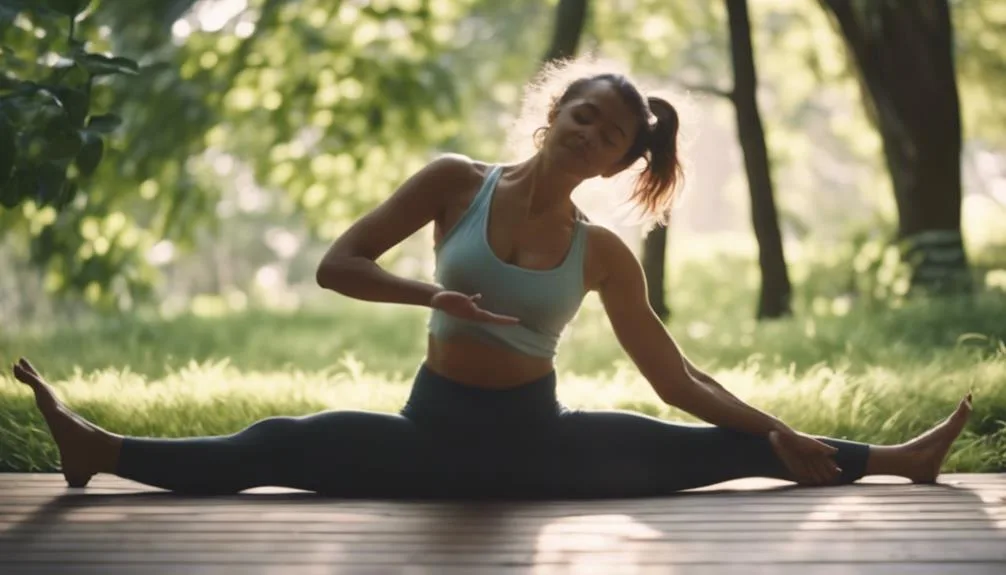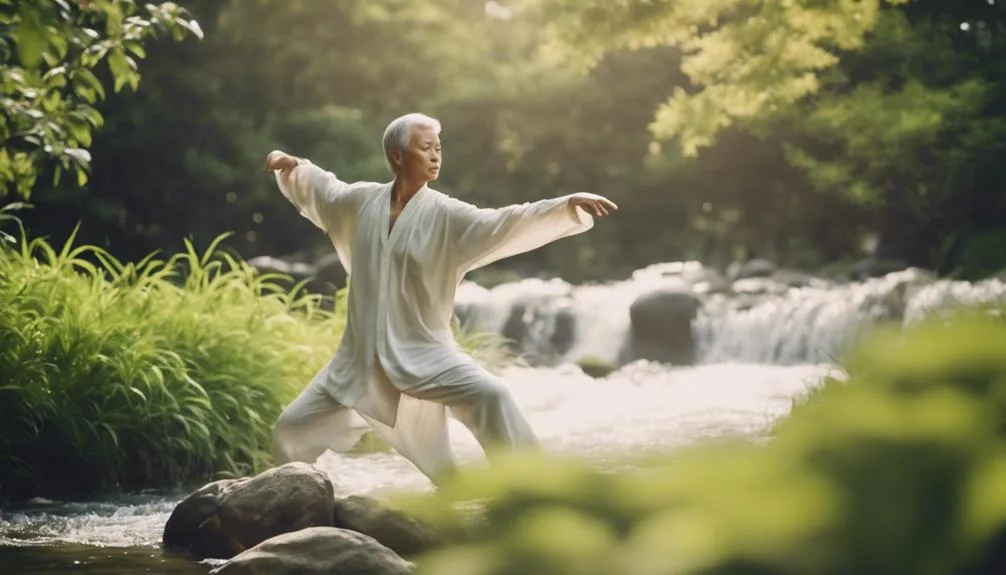Are you aware that according to recent research, movement meditation has been shown to increase focus and decrease symptoms of anxiety in individuals?
As you explore the concept of movement meditation, you'll uncover a world where mindfulness intertwines with physical activity, offering a unique approach to calming the mind and invigorating the body.
This practice goes beyond traditional seated meditation, inviting you to embrace a dynamic form of self-discovery and tranquility.
Unravel the secrets of movement meditation and embark on a journey towards a more centered and harmonious existence.
Key Takeaways
- Movement meditation enhances mind-body connection and promotes relaxation.
- Incorporating mindful movement breaks into daily routines boosts mental clarity.
- Various techniques like yoga, qigong, and dancing offer diverse approaches to moving meditation.
- Starting with walking meditation and exploring different practices can help refresh your mind effectively.
Benefits of Movement Meditation
Discover the numerous benefits that movement meditation offers for enhancing your overall well-being and mindfulness. By incorporating movement into your meditation practice, you can experience improved focus and concentration.
The relaxation techniques used in movement meditation can help calm your mind and reduce stress levels, allowing for a greater sense of inner peace. This form of meditation not only benefits your mental well-being but also contributes to physical relaxation, promoting a holistic approach to self-care.
Embrace the opportunity to connect with your body through movement, cultivating a deeper awareness of your thoughts and emotions. Allow yourself to explore the benefits of movement meditation as a way to nurture both your mind and body in unison.
Techniques for Movement Meditation
Explore a variety of techniques for movement meditation to discover the one that resonates best with your mind and body.
- Mindful walking: Engage in slow, deliberate steps while focusing on each sensation and breath, grounding yourself in the present moment.
- Breathing techniques: Incorporate deep, intentional breathing into your movement practice to enhance relaxation, mindfulness, and the mind-body connection.
- Yoga poses, mindfulness integration: Embrace yoga's blend of physical postures, controlled breathing, and meditative practices to foster a harmonious connection between your body and mind.
Experiment with these techniques to find the one that speaks to you most profoundly, guiding you towards a deeper sense of inner peace and mindfulness. Each approach offers a unique pathway to self-discovery and holistic well-being.
Incorporating Movement Meditation Daily

To incorporate movement meditation into your daily routine, consider integrating mindful movement breaks throughout your day to promote stress relief and mental clarity.
Begin by setting aside short moments for mindful movement, such as a brief yoga session in the morning or a calming qigong practice in the afternoon. These breaks can help you refocus, recharge, and stay present amidst daily challenges.
Find opportunities to weave movement into your routines, whether it's through dancing while cooking, stretching during work breaks, or practicing tai chi in the park.
Getting Started With Moving Meditation
If you're new to moving meditation practices, starting with simple techniques like walking meditation can gently introduce you to the benefits of mindful movement. Exploring different techniques allows you to find what resonates best with you as you embark on this journey of self-discovery and inner balance.
Here are some ways to begin your moving meditation practice:
- Take a stroll: Walking meditation can be a peaceful way to connect with your surroundings.
- Embrace fluidity: Dancing meditation offers a unique blend of movement and mindfulness.
- Clean with purpose: Mindful cleaning turns everyday chores into opportunities for reflection and presence.
Specific Practices in Movement Meditation

As you deepen your exploration of movement meditation, specific practices offer unique avenues to cultivate mindfulness and inner balance. Engaging in mindful stretching can enhance your body awareness, promote deep breathing, and improve flexibility. Incorporating Qigong poses into your routine, which are inspired by animal movements, deep breathing, and energy flow promotion, can help you connect with your inner self on a deeper level. By practicing these techniques consistently, you can nurture a sense of peace and harmony within yourself. Below is a table highlighting the key aspects of mindful stretching and Qigong poses:
| Mindful Stretching | Qigong Poses |
|---|---|
| Improves body awareness | Based on animal movements |
| Enhances flexibility | Promotes deep breathing |
| Cultivates deep breathing | Focuses on energy flow |
| Promotes mind-body connection | Connects with inner self |
Frequently Asked Questions
Can Movement Meditation Be Practiced by People With Physical Limitations or Disabilities?
Yes, movement meditation can be adapted for people with physical limitations or disabilities. Utilize adaptive techniques, modified movements, and assistive devices to make practices inclusive. Explore various methods to find what suits you best.
How Can Movement Meditation Be Integrated Into a Busy Work Schedule?
Incorporate mindful walking and office stretches during breaks. Try quick dance breaks and chair yoga for energy. Experiment with different techniques to find what fits your schedule. Remember, small steps lead to big benefits.
Are There Specific Types of Music or Environments That Enhance the Practice of Movement Meditation?
When moving in meditation, music can deepen your experience. Choose calming tunes or natural sounds to enhance your practice. Nature settings offer tranquility, while urban spaces challenge focus. Find what resonates with you and let the music guide your movements.
What Role Does Mindfulness Play in Movement Meditation Compared to Traditional Sitting Meditation?
In movement meditation, mindfulness guides your every step, aiding in heightened awareness and relaxation. Compared to sitting meditation, it deepens your mind-body connection through diverse techniques like walking, yoga, qigong, dancing, and more.
Can Movement Meditation Be Beneficial for Children or Teenagers, and if So, How Can It Be Tailored to Their Needs and Interests?
Movement meditation can benefit kids by enhancing focus, creativity, and emotional well-being. Teens can engage through dance, yoga, or mindful sports. Tailor practices to their interests for sustained engagement. Encourage self-expression and stress relief through movement.
Conclusion
Are you ready to embark on a journey of self-discovery and inner peace through movement meditation?
Take the first step towards a more mindful and balanced life by exploring the various techniques mentioned in this article.
Embrace the opportunity to connect with your mind, body, and spirit in a unique and uplifting way.
So, why wait? Start your movement meditation practice today and unlock the endless possibilities of self-expression and well-being.

